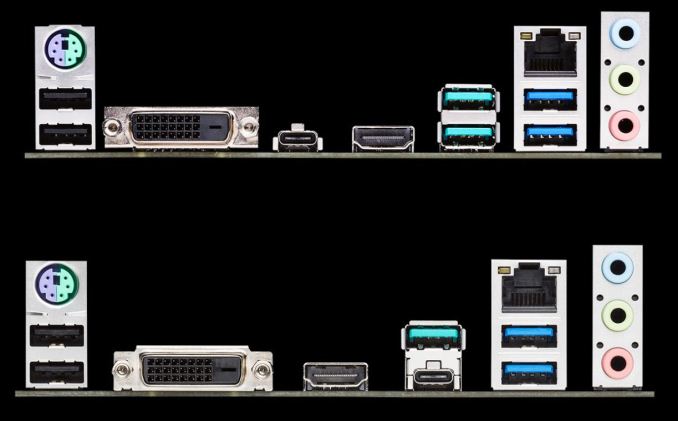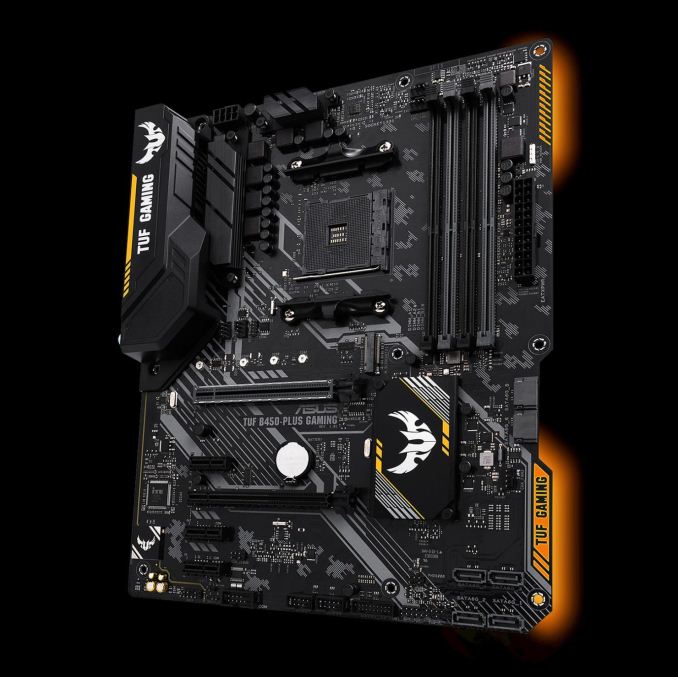Analyzing B450 for AMD Ryzen: A Quick Look at 25+ Motherboards
by Gavin Bonshor on July 31, 2018 8:00 AM ESTASUS TUF B450-Plus Gaming and
ASUS TUF B450M-Plus Gaming
Back in October last year, I went to an ASUS meeting at the UK HQ to talk about the upcoming Intel Z370 Motherboard launch where I was introduced to the ASUS TUF Z370-Pro Gaming and Z370-Plus Gaming. The TUF branding from ASUS is synonymous with boards such as the ASUS TUF X99 Sabertooth, so when ASUS HQ officials explained to me that the TUF (The Ultimate Force) brand was being re-arranged from a range with rugged looksand a longer than usual five year warranty to a more budget-focused gaming range which sits below the Strix range, it was somewhat nauseating. Nonetheless, ASUS states that they feel this is the best way forward for the brand, along with collaborations with memory and cooling manufacturers to be part of the TUF system.
With the launch of the new B450 chipset, ASUS has let loose two new TUF Gaming branded boards through the full-sized ATX TUF B450-Plus and the smaller TUF B450M-Plus.

The ASUS TUF B450M-Plus (left) and ASUS TUF B450-Plus (right) motherboards
Aesthetically speaking, both TUF B450 models have a near identical style with a customizable RGB section at the bottom right-hand corner, with both boards having a TUF branded chipset heatsink, dark grey metallic power delivery heatsinks and a rear panel cover which is black. The PCB also has a black and grey contrasting design printed on and the heatsinks have a yellow accented style which falls in line with the new TUF color scheme.
Both the TUF B450-Plus and B450M-Plus have very similar feature sets and component choices, with the main differences between the two coming through the form factor, which then naturally limits the PCIe 3.0 x1 capabilities of the B450M-Plus due to conforming to microATX standards. What both boards do share is two full-length PCIe slots with the top slot operating at PCIe 3.0 x16 and the second full-length slot operating at PCIe 2.0 x4 across both boards. The B450-Plus has a total of three PCIe 2.0 x1 slots, whereas the TUF B450M-Plus has a solitary x1 slot available.
Focusing on the power, ASUS looks to have equipped the same six phase Digi+ power delivery across both models, with the phases operating in 4+2 mode. Both boards have a metallic looking heatsink across the CPU section of the power delivery, while the SoC section does not. Power to the CPU comes from an 8-pin ATX 12 V input and power to the rest of the motherboard and chipset comes through a 24-pin ATX power input.
Both the TUF B450-Plus and B450M-Plus share the same storage options which primarily consists of six SATA ports with both models having four straight angled connectors, and two right-angled connectors emanating from the board. Users looking to make use of RAID storage configurations will be pleased to know both boards can accommodate RAID 0, 1 and 10 arrays. There is also a single PCIe 3.0 x4 M.2 slot featured on both models with support for drives up to a size of M.2 22110 (22 x 110 mm) and allows for both PCIe and SATA varieties of SSD to be used.
With the latest AM4 chipsets offering better memory capabilities out of the box thanks to a wave of firmware updates, both the TUF B450 boards take advantage of DDR4-3200 support from the get-go, with both having four memory slots giving the pairing a total combined memory capacity of up to 64 GB. The TUF boards also support ECC memory, but ASUS does state this support varies depending on the CPU.
In terms of cooling options, the ATX sized TUF B450-Plus has a total of five 4-pin fan headers dotted around the board which are split between one header to the CPU fan, three specifically for case fans and a single header dedicated to an AIO CPU cooler pump. The size limitation strikes the smaller microATX TUF B450M-Plus as only three 4-pin headers are present with a single one for the CPU fan and two for case fans. Both boards can have their USB real estate capabilities pushed beyond what’s on the rear panel with a further two USB 3.1 5 Gbps and four USB 2.0 ports being available through internal USB headers.

The ASUS TUF B450-Plus rear panel (top) compared to the ASUS TUF B450-M Plus rear panel (bottom)
Directing the attention to the rear panel, both boards have near indistinguishable layouts and connection choice with both boards having a PS/2 keyboard and mouse combo port, a single DVI-D and HDMI port, three 3.5mm audio jacks to make use of the Realtek ALC887-VD2 audio codec. On top of this is a single LAN port which is controlled by a Realtek RTL8111H Gigabit networking chip. The only differences come through the USB connections with the TUF B450-Plus having two USB 3.1 10 Gbps Type-A ports, a single USB 3.1 5 Gbps Type-C, two USB 3.1 5 Gbps Type-A ports and two regular USB 2.0 ports. The smaller ASUS TUF B450M-Plus has a single USB 3.1 10 Gbps Type-A port, a single USB 3.1 5 Gbps Type-C port, two USB 3.1 5 Gbps Type-A ports and two standard USB 2.0 ports.
Both of the TUF B450 Plus models have a unique styling with the black and white contrasting PCB, with yellow accents across the board and there is RGB expansion capability through a single ASUS Aura Sync-enabled RGB header on both for users looking to add their own flair and style. Both boards are near identical in features and with the B450-Plus Gaming set to retail for $119.99 and the smaller B450M-Plus Gaming coming in at a slightly cheaper price of $99.99, both look to offer value to users without scrimping too much on feature set.



_thumb.jpg)
_thumb.jpg)
_thumb.jpg)
_thumb.jpg)
_thumb.jpg)
_thumb.jpg)
_thumb.jpg)
_thumb.jpg)
_thumb.jpg)
_thumb.jpg)
_thumb.jpg)
_thumb.jpg)








62 Comments
View All Comments
JohanPirlouit - Wednesday, August 1, 2018 - link
Thanks Sakkura ;-) .... And I also agree with you..patire - Wednesday, August 1, 2018 - link
The ASRock microATX B450M Pro4 has a total of four SATA ports not the six as wrongly posted on the final page table for choosing the right B450 Motherboard.Xajel - Thursday, August 2, 2018 - link
Yet not a single high-end X470 mATX motherboard !!Xajel - Thursday, August 2, 2018 - link
Yet not a single high-end X470 mATX motherboard !!jensend - Saturday, August 4, 2018 - link
WHY ON EARTH DO THEY KEEP MAKING AMD BOARDS WITHOUT DISPLAYPORT?FreeSync is a game changer for the Ryzen APUs, and very few of the inexpensive adaptive sync displays support FreeSync over HDMI.
KAlmquist - Sunday, August 5, 2018 - link
Gavin Bonshor's otherwise excellant page on choosing the right B450 motherboard doesn't include a list of boards that support DisplayPort. Unless I've missed some, there are eight:ASRock B450 Gaming K4
ASRock B450 Gaming ITX/ac
ASRock B450 Pro4
ASUS ROG Strix B450-F Gaming
MSI B450I Gaming Plus AC
MSI B450M Mortar
MSI B450M Mortar Titanium
MSI B450-A Pro
I once had a motherboard with a Realtek network controller and got so sick of it randomly connecting at 10 mb/sec that I vowed I would never buy another Realtech network controller. That leaves only one B450 option:
ASUS ROG Strix B450-F Gaming
AdrianB1 - Sunday, August 5, 2018 - link
There is also the MSI B450 Carbon AC that in theory is better as it has better VRM and wireless LAN. It is also a bit cheaper in the stores in my area.DMCbr - Sunday, August 5, 2018 - link
I think MSI totally won this time, with the PRO Carbon AC board: best sound, best lan, wifi, 5+2 VRM phases, good heat-sinks...foxbat - Tuesday, August 7, 2018 - link
Great, really great ... but still can't buy outside of USA 13" laptop with Mobile Ryzen APU except extremely expensive not so well designed Lenovo 720S. What is the reason?Djoie123 - Tuesday, August 14, 2018 - link
I think that B450 gaming plus have 4+3 vrm phase design, on their site they said it's 7 phase power design